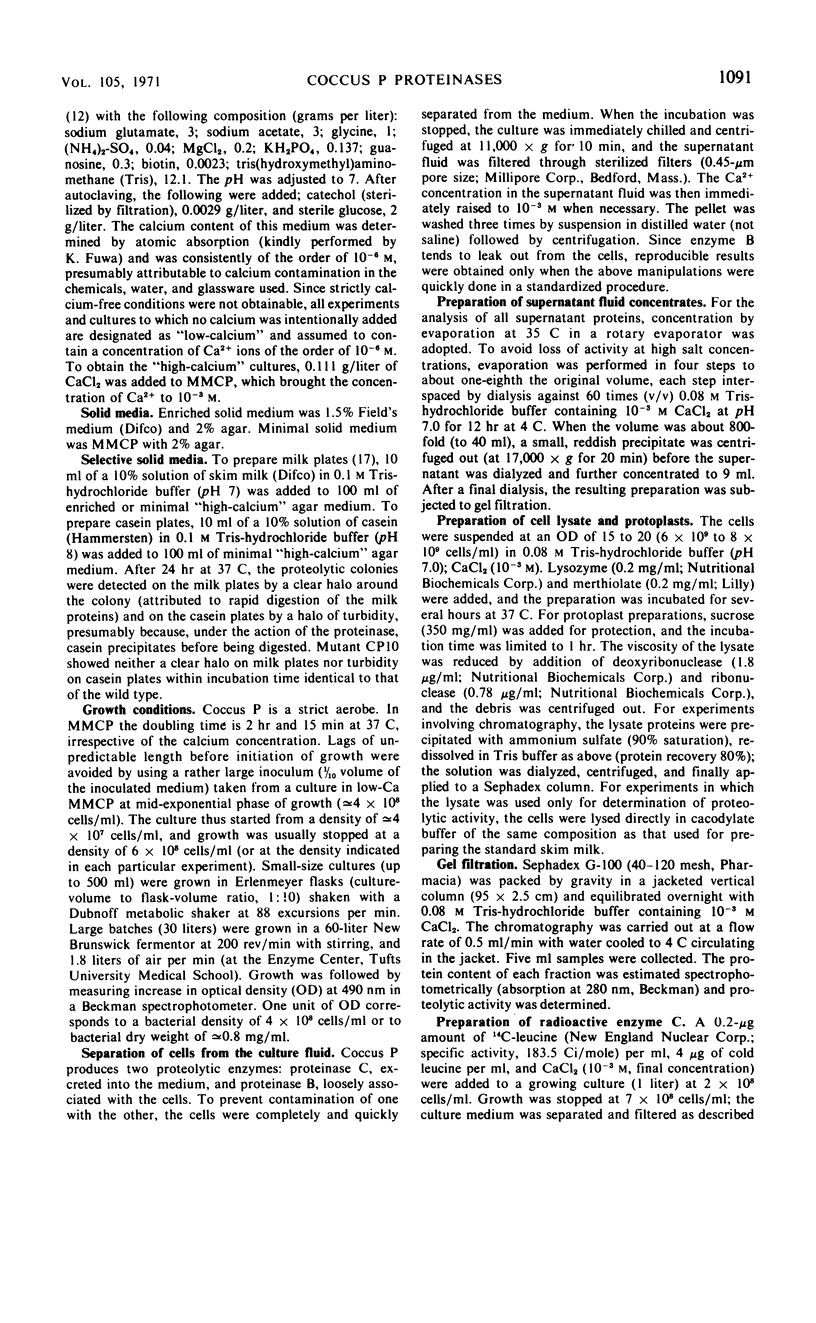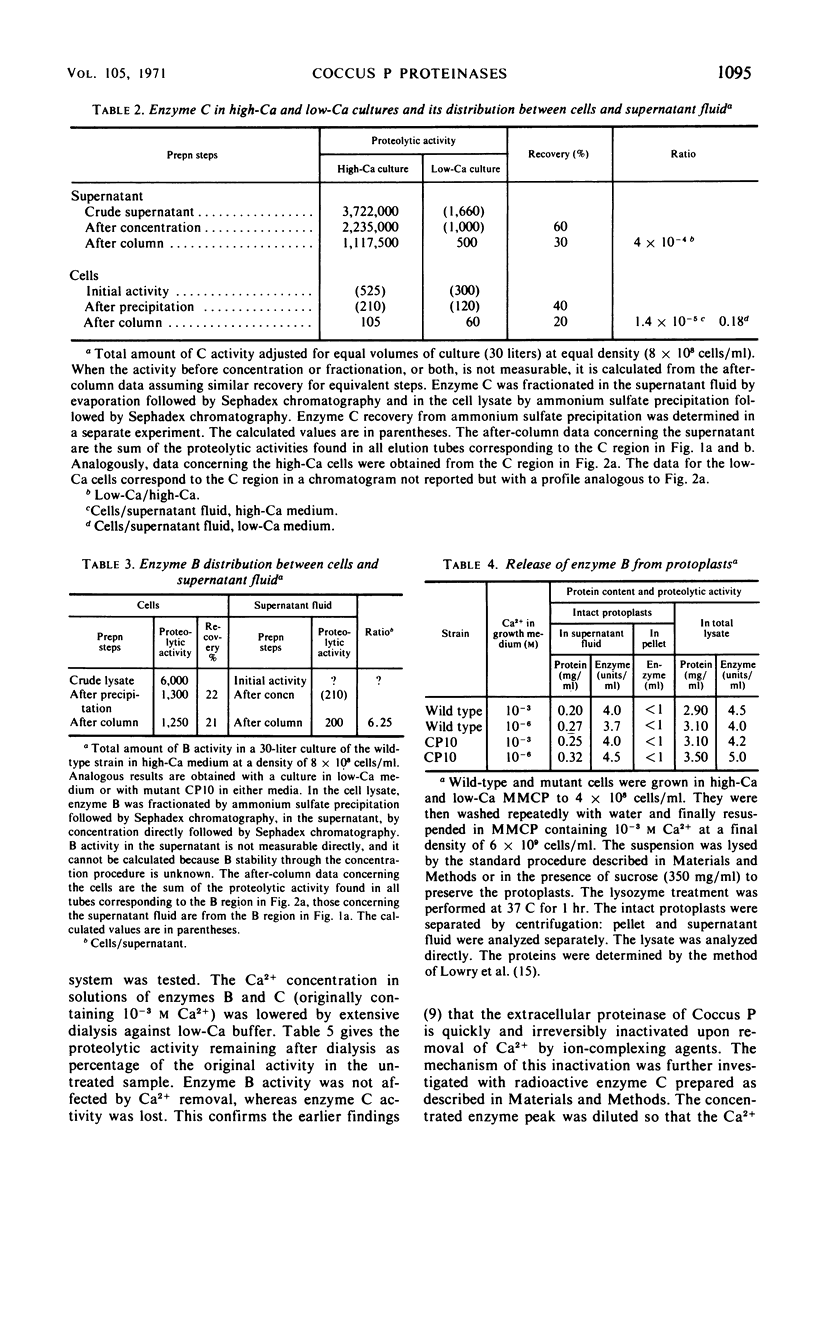Abstract
A Sarcina strain (Coccus P) produces two proteolytic enzymes. One is found only extracellularly, is far more prevalent, and is actively excreted during exponential growth. It is the enzyme responsible for the known strong proteolytic activity of the cultures of this strain. A second protease is, however, produced which remains associated with the intact cells but is released by the protoplasts. The two enzymes appear unrelated in their derivation. Calcium ions play an essential role in preventing autodigestion of the excreted enzyme.
Full text
PDF








Selected References
These references are in PubMed. This may not be the complete list of references from this article.
- Andrews P. Estimation of the molecular weights of proteins by Sephadex gel-filtration. Biochem J. 1964 May;91(2):222–233. doi: 10.1042/bj0910222. [DOI] [PMC free article] [PubMed] [Google Scholar]
- Bissell M. J., Tosi R., Gorini L. Mechanism of excretion of a bacterial proteinase: factors controlling accumulation of the extracellular proteinase of a Sarcina strain (Coccus P). J Bacteriol. 1971 Mar;105(3):1099–1109. doi: 10.1128/jb.105.3.1099-1109.1971. [DOI] [PMC free article] [PubMed] [Google Scholar]
- COLOBERT L. Etude de la protéinase de Coccus P (sp. Sarcina flava). I. Purification. Bull Soc Chim Biol (Paris) 1957;39(7-8):919–926. [PubMed] [Google Scholar]
- COLOBERT L. Etude de la protéinase de Coccus P (sp. Sarcina flava). II. Caractères de solubilité. Bull Soc Chim Biol (Paris) 1957;39(12):1455–1463. [PubMed] [Google Scholar]
- COLOBERT L. Etude de la protéinase de Coccus P. III. Spécificité. Bull Soc Chim Biol (Paris) 1958;40(2-3):423–429. [PubMed] [Google Scholar]
- GORINI L., FELIX F. Sur le mécanisme de protection de la trypsine par Ca++ ou Mn++. Biochim Biophys Acta. 1953 Aug;11(4):535–542. doi: 10.1016/0006-3002(53)90092-4. [DOI] [PubMed] [Google Scholar]
- GORINI L., LANZAVECCHIA G. Recherches sur le mécanisme de production d'une protéinase bactérienne. I. Nouvelle technique de détermination d'une protéinase par la coagulation du lait. Biochim Biophys Acta. 1954 Jul;14(3):407–414. doi: 10.1016/0006-3002(54)90200-0. [DOI] [PubMed] [Google Scholar]
- GORINI L., LORD R. Nécessité des orthodiphénols pour la croissance de Coccus P (Sarcina sp.). Biochim Biophys Acta. 1956 Jan;19(1):84–90. doi: 10.1016/0006-3002(56)90388-2. [DOI] [PubMed] [Google Scholar]
- GORINI L. Le role du calcium dans l'activité et la stabilité de quelques protéinases bactériennes. Biochim Biophys Acta. 1950 Nov;6(2):237–255. doi: 10.1016/0006-3002(50)90097-7. [DOI] [PubMed] [Google Scholar]
- Heppel L. A. Selective release of enzymes from bacteria. Science. 1967 Jun 16;156(3781):1451–1455. doi: 10.1126/science.156.3781.1451. [DOI] [PubMed] [Google Scholar]
- LOWRY O. H., ROSEBROUGH N. J., FARR A. L., RANDALL R. J. Protein measurement with the Folin phenol reagent. J Biol Chem. 1951 Nov;193(1):265–275. [PubMed] [Google Scholar]
- MATHESON A. T., TIGANE E., HANES C. S. Quantitative chromatographic methods. 5. An improved ninhydrin-hydrindantin reagent. Can J Biochem Physiol. 1961 Feb;39:417–425. doi: 10.1139/o61-040. [DOI] [PubMed] [Google Scholar]


